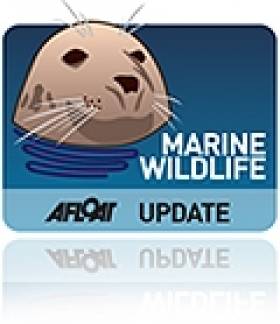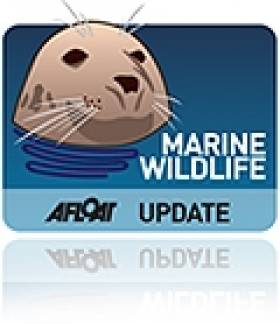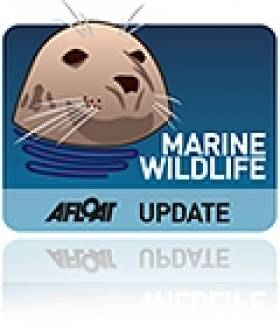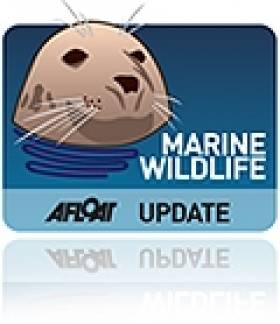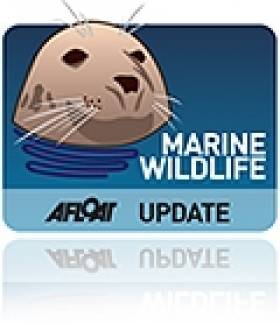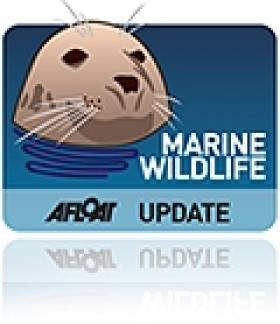Displaying items by tag: seals
Seal Pup Found On Galway Street Is On The Mend
#MarineWildlife - 'Poison Ivy' the seal pup is now in good hands after she was found on the streets of Galway by council workers earlier this month.
As the Galway Independent reports, the young seal was discovered on the footpath in Salthill by litter collectors and was cared for locally by vets, members of the public and volunteers with Galway & Claddagh Swan Rescue.
She has since been transferred to the Seal Rescue Ireland sanctuary in Wexford, where she is said to be thriving after treatment for dehydration and malnourishment, an eye infection and a number of infected wounds.
It's thought that since she still had half of her lanugo fur coat, she was less than three weeks' old when found – "so there is a good chance that little Poison Ivy was separated from her mom too early," said the sanctuary's manager Meadow Greenwood.
As for the name? It's part of a comic book theme at the sanctuary, which earlier in the year played host to the like of Blackbird, a seal rescued in Co Louth, and Mystique from Co Mayo, according to the Gorey Guardian.
In other marine wildlife news, there has been anger in Northern Ireland after an otter was found killed in a trap on a riverbank in Co Antrim last weekend.
According to the Belfast Telegraph, the PSNI is investigating the incident on the banks of the Sixmilewater River at Dunadry as the placement of the trap "suggests a deliberate attempt to target the otter" – a protected species at EU level.
And as a member of the Antrim and District Angling Association alleges, whether or not the trap itself is legal is irrelevant as its placement was not.
"There is a residential development backing onto that area ... A cat or a dog or a young child could have been caught in that trap."
The Belfast Telegraph has more on the story HERE.
Seals Not Competing With Commercial Fishing Stocks, Says New Research
#MarineWildlife - Seals are not threatening commercial fishing stocks in Irish waters, with the possible exception of wild Atlantic salmon, according to new research led by Queen's University Belfast.
The findings show that seals are having no significant impact on populations of the most popular species of fish caught for commercial purposes along the south and west coasts of Ireland from Galway to Waterford.
The first comprehensive study of its kind, the conclusions of this research – led by QUB in collaboration with University College Cork and the Marine Institute – suggest that the seals do not compete with fishermen over the stocks.
The issue of seals in Irish waters has been controversial in recent years, and there have been calls from some quarters for culls of the common marine mammals.
"We need to emphasise that this work in no way says that seals cause no problems for the fishing industry," said lead researcher Dr Keith Farnsworld of QUB. "They do create significant problems for static fishing gear, such as the fixed nets used by estuarine salmon fishers, and they may also impact on numbers of wild salmon, although most salmon eaten on these islands is farmed.
"What we are saying is that for most commercially fished species off the south and west coasts of Ireland – herring, mackerel, cod, haddock, whiting and 30 other species – seals are having no significant negative effect on numbers.
"This is because the seals are eating much smaller fish than the larger, mature specimens that fishermen are required by law to catch. So seals are often eating the same species of fish as we buy in the supermarkets, but younger versions of them. And there are hundreds more younger fish than mature fish in any given species.
"In fact, we found evidence that seals may actually be doing the fishermen a favour, by eating some species that prey on the valuable stocks the fishermen are after."
Prof David Reid of the Marine Institute added that "what this work shows is that the only way to really resolve questions like this one is to be able to actually look at the detail, and work out what is going on.
"This work used material as diverse as the gut contents of the seals and the fish, through seal 'scat', to samples taken from commercial catches and research vessel surveys, and elaborate mathematical models.
"The idea of seals being direct competitors with the fishing boats for the fish out there intuitively seems pretty obvious. But actually, in this case, it is not really true. They both 'eat' fish. But not the same fish, and they do not compete with each other.
"This is not to say," he added, "that seals do not compete with fishermen in other ways. In other recent work we showed that fishermen who use set nets round the coast of Ireland can lose fish straight out of their nets to seals. But as with this study, we needed to go into the detail, and get our hands dirty to prove that."
The findings of this new research are based on data from an area roughly 100 miles off south and west Ireland, encompassing the coastlines of counties Waterford, Cork, Kerry, Clare and Galway. The data was collected from seal droppings of both grey and common seals and collated by researchers from University College Cork.
Supplementary information was obtained from the Marine Institute and the International Council for the Exploration of the Seas (ICES).
The data was then interpreted by researchers at QUB's Institute for Global Food Security. Their conclusions have been published today in The Journal of Applied Ecology.
The study will be good news to the ears of seal fans in Northern Ireland, whose grey seal population is having a bumper year in 2015, as BBC News reports.
Co Down in particular is reporting strong numbers at such seal-friendly locations as the Copeland Islands and Strangford Lough, where 107 seal pups were counted this year – a sign of good health for the ecosystem as a whole.
BBC News has more on the story HERE.
Video Shows Basking Shark On Patrol Off Dingle
#MarineWildlife - Following Friday's look back at the basking shark that surprised bathers off Cape Clear last summer, Independent.ie brings us this remarkable up-close video of the ocean giants returning to the Kerry coast for the warmer months.
The footage was captured near Dingle by sea kayaker Noel O'Leary, who said: "I’ve seen the odd minke whale, but to see a shark that's bigger than the kayak so close is quite amazing."
But it wasn't the only surprising sight around Ireland's coast as of late, as Her.ie reports on a 'surfing seal' in Dungarvan.
Apparently, the seal has become somewhat of a local celebrity after taking a liking to an abandoned surfboard at the mouth of the Colligan river.
Whether the cuddly sea dog is ready to take on the big waves of Mullaghmore remains to be seen!
Dutch Step In To Keep Seal Rescue Centre Open
#MarineWildlife - Courtown's seal sanctuary has been saved from closure after Dutch counterparts stepped in to help fill a key vacancy over maternity leave.
As the Wexford People reports, Sonja Ciccaglione has now been seconded as temporary manager of Seal Rescue Ireland's Wexford base.
And she joined the group's volunteers at the latest release of rehabilitated seals last weekend.
Luckily for the staff-strapped marine wildlife centre, it's a quiet period with only a couple of seals remain in residence – but donations from the public are always welcome.
Lisburn's Resident 'Sealebrity' Lights Up Social Media
#MarineWildlife - Northern Ireland's Exploris aquarium has put out a call to Lisburn locals to help them track down a notorious resident seal who's become somewhat of a landlubber.
As Lisburn Today reports, Sammy – as the seal's been named on social media – has been a regular fixture in the Laganside town for a number of years, and has recently been spotted as far as seven miles inland.
Various reports have described the unique habits of this 'sealebrity' who's been spotted walking the towpath at Lisburn's civic centre towards Hill Street near the centre of town.
But until now staff at Exploris have been unable to get a hold of Sammy to check on the seal's condition.
“We would very much like to get a closer look at her," they said in a recent appeal. "If you see her please call us!”
Elsewhere, sea lions in California are having a tough time of it due to rising ocean temperatures in the Pacific.
And according to Salon, it's a situation that will only get worse when the effects of human-induced global warming take hold.
Some 1,800 stranded sea lion pups have been recorded on California's beaches in just the first two-and-a-half months of this year, many of them in an emaciated state.
Warming waters hostile to key fish species and micro-organisms have been blamed for this phenomenon, as the sea lions are forced to swim exhausting distances for sustenance.
The flight of fish to more suitable temperatures elsewhere is also having an impact on fishing communities up and down America's western seaboard.
But while the cause of the current 'hot spot' may be "a fluke of climate variability", for some experts it points to future trends in the world's largest ocean. Salon has more on the story HERE.
Marine Wildlife News: Seals Returned To Wild, Dolphin Says Adieu, Irish Sea Life Revealed
#MarineWildlife - Cute by name, cute by nature: Sherkin, Buoy and Splash were returned to the wild after being nursed back to health by the volunteers at Seal Rescue Ireland.
As the Irish Examiner reports, the three young seals – rescued after tips from the public from locations in Cork and Kerry – were rehabilitated over the past three months at the new marine wildlife refuge in Courtown.
But they were finally fit to return to the open water last weekend at Fountainstown beach in Co Cork. The Irish Examiner has much more HERE.
As three return to Irish waters, another says adieu – as Clet the lone dolphin has now been spotted off the Dorset coast, according to the Bournemouth Echo.
Last spotted between Ireland and Scotland's west coast in December, the solitary cetacean first noted in French waters in 2008 appears to have completed a full loop around the island of Ireland.
Along the way he bypassed Dingle's famous resident Fungie and spent a few days in the company of fellow 'dolphina-non-grata' Sandy, also known as Dusty.
Now he's attracting the attention of locals at Portland, south of Weymouth, across the English Channel from his original splashing grounds.
Closer to home, conservationists in the the North West of England have released a video documenting the wealth of wildlife living in the Irish Sea as a reminder to political movers and shakers of the importance of its protection.
Groups such as the North West Wildlife Trusts have criticised Westminster for 'lack of ambition' over the past year since plans for a network of well over 100 Marine Conservation Zones (MCZs) were scaled back to just 27 approvals in November 2013.
More recently a further 23 MCZs were designated proposed, only two of which are out of out of seven proposals covering the waters between Britain's west coast and Ireland (updated Tuesday 17 March).
Lookout Urged For Beaches Turtles After Rare Species Find
#MarineWildlife - Seaside visitors are being asked to look out for turtles washed up on the shore after a rare example of the world's smallest sea turtle was discovered in Donegal over Christmas.
According to the Irish Independent, the body of the foot-long Kemp's ridley turtle – declared by National Geographic to be the most endangered sea turtle species on earth – was found on the rocks at popular surfing spot Rossnowlagh beach on Christmas Day.
It turned out to be one of four such turtles discovered in the British Isles in just the last few weeks – far from their usual, much warmer climes in the Gulf of Mexico.
And they're not the only marine wildlife to look out for, as photographer David Comerford tells TheJournal.ie about a stranded seal pup he found at the Sutton end of Bull Island last night.
The little seal "appeared to be in good health" though it has "a clear injury to one of its flippers". The Irish Seal Sanctuary has been notified and is co-ordinating a response with local vets.
Update: The Irish Times has video of the seal pup returning to the sea as the tide came in.
Courtown Sees Off Latest Rescue Seals
#MarineWildlife - After last week's good news of a seal pup rescue in Northern Ireland, on the other end of the island a number of similar rescue seals got a fresh start for the New Year.
The Gorey Guardian reports on the release of five seals - named Flotsam, Misty, Skipper, Marina and Ariel - by the Courtown Seal Rescue Centre from the Wexford town on 2 January.
The marine mammals in question were picked up from beaches along the east coast from Ballinesker to Rosslare in various states of injury and distress, and rehabilitated over a number of months.
In the case of Skipper in particular, it was cheering to see him return to the waves fighting fit months after he was discovered emaciated with propeller wounds.
The Gorey Guardian has more on the story HERE.
Young Seal Found Lost & Exhausted In Muddy Field Far From Sea
#MarineWildlife - A very lost seal has been rescued after it was found exhausted in a field some 30km from the Irish Sea in northern England yesterday (22 December).
Yahoo News! reports that the young male grey seal was spotted by a dogwalker in a muddy field at Newton-le-Willows in Merseyside - and after some hours of attempts by rescuers, it was coaxed into a trailer and taken to a local wildlife hospital.
It's believed the young marine mammal swam up a tributary of the River Mersey from the Irish Sea on the trail of fish before getting hopelessly lost in the landlocked village north of Warrington.
Locals Look Out For Seal Pup In Malahide
#MarineWildlife - The Dublin People has a heartwarming story of kind Malahide locals looking out for a lone seal pup earlier this month.
The little one was found by swimmer David Tuite sitting alone on a rock at Low Rock near the north Co Dublin town, and "seemed totally relaxed and unbothered".
Nevertheless, Tuite got on the phone and was connected with Seal Rescue Ireland, who assured him that the juvenile was just fine - a useful reminder to people not to get too involved if they seen any marine wildlife they think might be in distress.
The Dublin People has more on the story HERE.


























